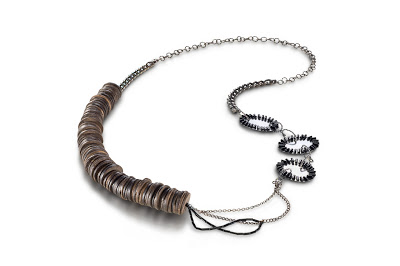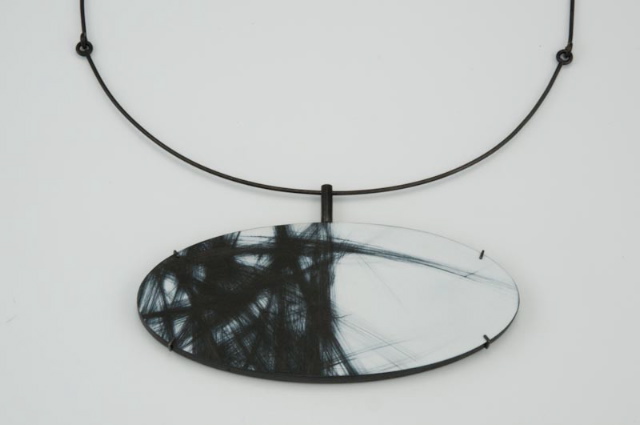Raïssa Bump received her B.F.A. in Jewelry and Metals at Rhode Island School of Design and studied at Alchimia School of Contemporary Jewelry in Florence Italy. She has taught at various colleges including the revered Penland School of Crafts and locally at Diablo Valley College. I had the opportunity to talk with her about her practice and her current body of work being shown at Shibumi Gallery in Berkeley. Read what Raïssa has to say about her current show, “Circulation” and then go see the work.
One of the last things that we were talking about at your opening was sketching in 3-dimensions with tangible objects vs. making an actual drawing and you said that it was difficult for you to get ideas out by planning on paper. On the other hand there are artists who need that plan or blueprint before they can begin to make a piece. So, what is it about that type of artist production that is more fruitful for you?
Probably because, in one way, my skills with drawing are not as developed but that’s besides the point because I think if drawing felt right to me I would find ways to make it more of an outlet. I certainly don’t feel like I need a blueprint before I start. Regardless of where the idea is, I like to have a tangible beginning point and then just work from there and evaluate as I go along.
I work through my hands. That’s where my spirit connects. I think it’s how I experience life too. It’s more about the experience and being able to see it instead of just imagine it. I can respond a lot more to that. And for me it’s harder to make decisions if something doesn’t already exist. I find that I can be more responsive and have a clearer idea about a piece when I’m brainstorming in 3-dimensions. And after all, the end result is a 3-dimensional thing. That’s probably why I have so many leftovers.
Right, instead of a sketchbook you probably have boxes and piles and things like that.
Yeah, its gives me more information. For the most part, I sketch after I already have an idea I’m working out in 3-dimensions and I say to myself, “before I go to the next stage I’m going to draw this out in different sizes so I can get a visual. Or I cut it out in paper. Paper is more tactile.
So then, along those lines how do you know when you’re finished? How do you know when you have reached the end product so to speak?
That’s not always so direct and so easy. I have a table where I have bits and pieces that I’ll arrange in a composition. I’ll leave it like that for a day or maybe I’ll move it around or add something else and feel it out. It’s a lot of intuition, of allowing time. It doesn’t always happen fast. I look at a composition for a while and then I start putting it together, actually constructing it. Eventually I wear it around my studio and sometimes out on the streets. I have to put it on the body and see how it wears, see how I feel in it, see how it looks when I walk in front of a mirror or if it hangs strange. I actually, especially with this body of work, make a lot of little changes at this stage. So, it’s a process of allowing enough time for each piece.
So, then are you kind of working in between pieces, going back and forth or do you tend to focus on one piece until you get it right and then move on to the next?
Rarely do I work on one piece and then go to the next and then the next. In my general process I have many pieces going on at once and it allows me to not get stressed out. Some pieces end up being something and some ideas don’t for the moment. It makes more sense to allow that time that I was talking about in order to feel the work intuitively and to keep looking at it at different moments, different moods, different times of day, different light…
The title of this show is “Circulation”. Would you in general talk a little bit about Circulation and what that means to your work?
I like the idea of this continuous motion. That was one of the things I responded to when choosing the title, this cycle and idea that one thing leads to the next in an ongoing, continuous flow. So that’s how I viewed it as I was working. It was this process of looking at myself throughout different time periods of my life and addressing that. As people, we interact with the world and we can’t avoid flow. One thing leads to the next, leads to the next and our experiences lead us to where we are today. So circulation is a reference to the years, the story, the information, the knowledge and interests that went into the work. Also, I like the idea of thinking of circulation in another context, as how things get spread. Like newspaper circulation, how something moves out and about in the world, how it circulates. It feels like that’s where I’m at in my life. I’m putting myself out there in the public and getting the work out there. I really do feel like these necklaces, earrings and brooches are lyrical collages that speak to all the different fragments of me, but at the same time can move away from me and mean something to someone else.
Right. I like that double meaning. The circulation that deals with the making of the work as well as the physical circulation of the work itself once out in the world. Especially because it is unique to a discipline like jewelry. You could make a 2-d work or a sculpture for that matter but it would be on the wall or somewhere more permanent. But jewelry is so interesting in that it’s constantly moving through the day to day.
Yeah, which is lovely. It moves from mood to mood, space to space and person to person. Jewelry does go to museums or certain places and just stay put but not in general.
As artists we tend to scrutinize what we make all the time. If I were to look back at something that I didn’t consider part of my artwork I might not care so much but when I put things in this category of, “This is my art,” then it becomes so much more magnified. I was thinking of myself going through your process and I wondered, would I want to look at pieces or parts or things that I made 15 or 20 years ago?
It’s interesting too, because some of it dates back to when I was young or even through high school when I wasn’t thinking of it in the context of, “I’m making art.” It was just that pure love of using my hands, getting time to myself and quietly doing all these intricate and repetitive things. Then on top of that, having something as a result of that time spent. I love that. I always like having nothing in my hands and then creating something, and realizing, “Wow, now I have a necklace to wear out tonight or a hat because its cold,” and having that skill is something I really am thankful for.
However, there is a time when it did start to become a harder process. For me the critical moment when it shifted was after college, when I was trying to make money and make this my thing. As far as the pieces I made during this time period, I probably took them apart so much that they are in disguise from what they originally were. They weren’t so interesting to me the way they were.
You said at the gallery talk that your household was a little chaotic and you looked forward to these times when you could steal away by yourself. In terms of this group of work I like picturing what your household was like and I was wondering if you could just give me a little bit of a background on your upbringing?
Sure. I certainly got along with my family. It’s just that I had 3 older brothers and a younger sister. We didn’t have a set routine every single day. It was just sort of, whatever needed to happen, happened. So there was a lot of flexibility in some ways and a lot of unknowns. I found myself wanting quiet time. So I would get away and do my own thing for a while. And that’s what it felt like—getting away from a constant motion.
Was that part of your parents philosophy, that flexibility?
I think that my family was willing to avoid making things super static, which I really appreciate. There were certainly rules and some formality about things. But there was rarely a time where it was just, “This is what it is and no matter what the scenario comes up, I’m not going to consider anything else.” That allowed for a lot to happen. It’s interesting because the house was always changing. We were fixing the house, furniture would move around and in a sense there was a lot of creation.
I was wondering if you had one piece out of the group that especially spoke to you and if you could elaborate.































